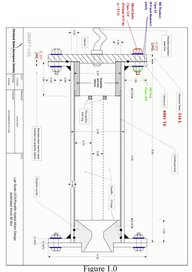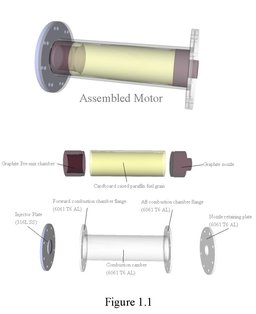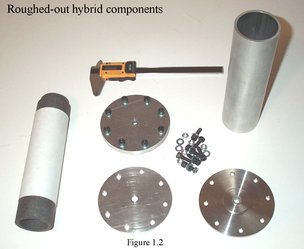Combustion Chamber Safety Analysis Criteria
Ver1.0
Before static firing our gaseous oxygen/ paraffin hybrid rocket motor we will perform a safety analysis and possible design iterations to help maximize our chance of success.
Rocket motors can be dangerous systems, therefore to reduce the danger we are using hybrid technology which is inherently safer than many other forms of propulsion. We will make a positive attempt to minimize any risk to participants and property.
The actual static test hardware and static test procedure will take into account a ‘worst case scenario’ of motor failure and be designed and implemented with this in mind. We want to take every precaution to avoid this scenario, but if it were to occur we would have reasonable confidence there would be minimal damage.
A safety analysis of the combustion chamber will be performed in the following areas:
- Pressure vessel analysis
- Forward bolted connection analysis
- Aft bolted connection analysis
- Flange to chamber weld analysis
* (This is an initial attempt. If you see something missing or lacking please amend page or notify propulsion team)
Given:
- Both static and dynamic (fatigue) failure criteria will be used.
- A minimum factor of safety =2 will be adhered to.
- For fatigue analysis the ASME elliptic model with Von Mises equivalent stress will be used
Assumptions:
- Chamber pressure = 500 psi
- Maximum chamber pressure fluctuations = 25% of mean chamber pressure [1]
- Thermal effects will initially be neglected because of short burn times and insulative properties of fuel grain (Temperature factor = 1)
- Loading is purely axial. (Size factor =1)
Find:
1) Pressure vessel analysis: (See Figure 1.0)
- Combustion chamber material is 6061 T6 aluminum OD = 2.35” Length = 8.00” THK= 0.140”
- Only use thin wall assumption if radius to thickness ratio = 20:1 [2]
- For static analysis find maximum tensile and shear stressed in plane and out of plane. *Calculate safety factor using given material properties
http://www.matweb.com/search/SpecificMaterial.asp?bassnum=MA6016
- For dynamic analysis use Von Mises equivalent stress with ASME elliptic
- Sigma alternating = 25% sigma mean [1]
- Find corrected endurance limit using correction coefficients as applicable to [2].
2) Forward bolted connection analysis: (See Figure 1.0)
- Material #1 = SS 316L annealed plate (0.205 inches thick)
http://www.matweb.com/search/SpecificMaterial.asp?bassnum=Q316P
- Material #2 = 6061 T6 aluminum (0.1875 inches thick)
http://www.matweb.com/search/SpecificMaterial.asp?bassnum=MA6016
- Assume reusable connection (75% of proof load)
- Use static and dynamic situations
- Use both bolt yielding and joint separation failure criteria
- Fatigue analysis – Von Mises equivalent stress, ASME elliptic, S.F. =2
- Assume bolts extend from nuts 2 threads
- No shanks on bolts
3) Aft bolted connection analysis: (See Figure 1.0)
- Material #2 = 6061 T6 aluminum (0.1875 inches thick)
http://www.matweb.com/search/SpecificMaterial.asp?bassnum=MA6016
- Material #2 = 6061 T6 aluminum (0.1875 inches thick)
http://www.matweb.com/search/SpecificMaterial.asp?bassnum=MA6016
- Assume reusable connection (75% of proof load)
- Use static and dynamic situations
- Use both bolt yielding and joint separation failure criteria
- Fatigue analysis – Von Mises equivalent stress, ASME elliptic, S.F. =2
- Assume bolts extend from nuts 2 threads
- No shanks on bolts
4) Flange to chamber weld analysis: (See Figure 1.0)
- Coming soon! Practicing TIG welding and learning more about weld quality.
References:
[1] NASA /TP -2000-209905
[2] “Mechanical Engineering Design”, Shigley & Meschke 5th ed.
-- ?BrianONeel - 09 Aug 2003
Attachments:


